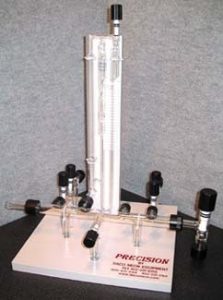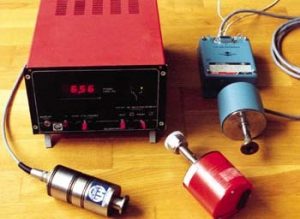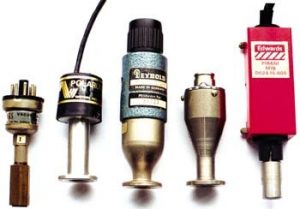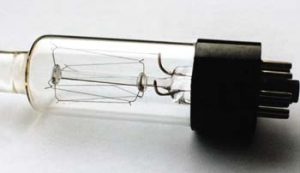LEDs + Lighting
Guess or Gauge?
Suitable and necessary gauges for neon processing
Published
18 years agoon
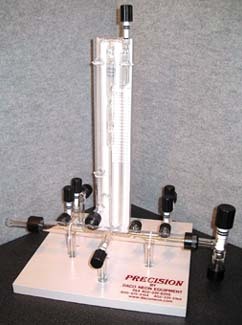
This month’s subject is one which I’ve been asked about numerous times. People have asked, "My old gauge broke. Which one should I use now?"
For this column, I’ll discuss the pros and cons of different gauges. However, if uncertain, you should ask gauge manufacturers about each product’s operating principle. It’s a gauge’s physical principle that determines whether it’s suitable for use in a neon shop. Note that my discussion is merely an overview of operating principles, not available brands or products.
Filling gauges
First, I’ll examine gauges suitable for determining a tube’s pressure during bombarding and filling, but not intended for high-vacuum measurements. It’s necessary to have two gauges — one for filling and one for vacuum measuring — because a single, principle gauge can’t cover the required range.
The oldest means of measuring vacuum is via a straight mercury column.
Normal atmospheric pressure at sea level will force mercury into a glass tube up to 30 in. Thus, such a gauge can be made by simply connecting a vertical piece of tubulation glass (measuring at least 35 in. tall) to the manifold, immersing the lower end into a jar with mercury, and placing a movable millimeter scale behind the tube.
At least twice daily, pump to high vacuum and adjust the scale so the upper mercury level reads "zero." Every millimeter lower will indicate 1 Torr of pressure. This gauge’s advantage is that, when zeroed properly, it will maintain its calibration, doesn’t require a stopcock, will read gas independently and continuously, and is very inexpensive.
However, you’ll be exposed to open mercury, which evaporates and contaminates the air. Plus, if a tube breaks, you must deal with a big mercury spill. Also you may need a magnification glass to accurately read less than 1/2 millimeter.
A safer version, which provides a more accurate readout, is marketed under numerous names, including U-gauge, EZ-read gauge and Butyl gauge (Fig. 1).
Such a gauge comprises a U-shaped glass tube, with both ends connected to the manifold (one end can be closed with a stopcock). Skilled neonbenders can make this type of gauge themselves — the filling media is diffusion pump oil (or butyl oil).
Unlike the mercury column, this is a relative gauge, which needs to be reset to zero every time a tube is evacuated. Note that the scale is fixed once the gauge is filled and both levels are equal. The scale must be calibrated, or scaled according to the specific weight of the oil, meaning there are different scales for butyl oil — DC702, DC704, etc.
Due to the media’s much lower specific gravity, compared to mercury, the scale is spread. Thus, you can easily read a precision of more than 0.2 mbar. Zeroing the gauge every time, by turning the stopcock, might become burdensome; however, this gauge is safe and always accurate (if zeroed properly).
The dial gauge is a simple mechanical gauge analog to the dial-type barometer, comprising a can that can expand and contract due to its bellows structure, which contains a good vacuum. The expansion and contraction, which is magnified mechanically, moves a dial over a scale.
This gauge is simple, provides continuous reading and is safe to operate. But it’s pricey, and some designs are sensitive to sudden inrushes of air (when the tubulation breaks), causing the dial to slam against the dead stop. When this occurs, mechanical parts are usually bent, and calibration is lost, or the gauge’s pointer is stuck somewhere on the scale.
Recalibration is sometimes possible, but not always. Thus, some manufacturers supply "sinter metal diaphragms," or capillary tubes that act like a sponge and slow down the inrush. I strongly advise against using such "protectors," because the pressure equalization at high vacuum is so slow, you’ll never obtain a vacuum sufficient for a neon tube in a timely manner.
Overall, this type of gauge is widely used in neon processing and is often recommended.
Sometimes you can purchase these gauges directly from vacuum-equipment manufacturers for less than what neon-supply houses charge.
Next is the piezo gauge, an electronic gauge comprising a small ceramic element that turns pressure into electrical voltage, which is then amplified and displayed continuously. Most instruments available have a range of 1,200 to 0 mbar absolute, so their main purpose is to read atmospheric (barometric) pressure.
Consequently, their accuracy in reading the low mbar range (0.5 to 10mbar, where accuracy in neon processing is a must) is quite poor, even when sold for vacuum service.
Also, from experience, I’ve learned that these sensors age quickly and are very difficult to recalibrate, because their linearity is lost. Piezo gauges are inexpensive, but I’ve witnessed bad-tube production due to this gauge type’s erratic pressure display. Plus, most models are very sensitive to nearby high voltages, so I don’t recommend using them in a neon shop.
The capacitance gauge (Fig. 2) operates with a barometric can like the dial gauge, but with an electronic readout. It provides gas-independent readings, is very fast and accurate, and, due to nonexistent mechanics, is quite insensitive to sudden pressure rises.
The downside is that this gauge costs more than $1,500. Thus, it’s usually recommended for such high-end applications as hot-cathode lamp fabrication.
Vacuum gauges
Vacuum gauges are used to test neon units for proper evacuation prior to filling, find leaks in the manifold and test pump performance. They aren’t used to determine pressure during bombarding or filling, because their readout range is 1,000 to 1 micron (1 to 0.001 Torr).
The Pirani gauge (Figs. 3 and 4) comprises a heated filament of platinum, tungsten or other metals with high temperature coefficients of electrical resistance. The filament is exposed to the residual gases in the vacuum system, which carry away the heat via conduction. The filament’s temperature is determined by the residual gas’s heat conductivity, which, in turn, depends on gas type and pressure.
The filament’s temperature can either be held constant to measure the required heating power, or the power is kept constant, and the change in resistance, due to the filament’s temperature change, is measured.
The filament is very fragile (in some models, the wire diameter is only 0.00015 in.) and can be damaged easily from flashbacks (see ST, February 2003, page 16) and contamination. Note that gold filaments damage quickly due to mercury vapor present in neon systems. Thus, for neon service, platinum is the preferred filament material.
The Pirani gauge is widely used and sold under numerous trade names. Be sure to obtain an instrument with good, built-in, room-temperature compensation to avoid unrealistic readings. The gauge’s range and accuracy are sufficient for neon processing; however, periodic re-calibration is required.
The thermocouple gauge (Fig. 3) is similar to the Pirani gauge, but its heat power is kept constant, and the heater’s temperature is read via a tiny thermocouple attached to the filament. This gauge’s accuracy is also similar to the Pirani’s, but it has a slight delay in display.
The Penning gauge, also called the "Philips" gauge or "discharge" gauge, is a small discharge tube with two electrodes running on approximately 2kV DC. Under normal circumstances, the discharge would extinguish at pressures below 1 micron, but, in this case, an external magnetic field extends the ionization probability so that the gauge can read down to 0.0001 micron.
For operation, the vacuum must be better (exhibit a lower pressure) than 10 microns. Therefore, it would be useless for simple neon systems that operate only with a mechanical pump. For this reason, the Penning gauge is rarely used in neon production, but it can be helpful for hunting small leaks and determining final pump performance in cold-cathode and oven pumping systems. The reading is gas dependent and continuous.
SPONSORED VIDEO
Introducing the Sign Industry Podcast
The Sign Industry Podcast is a platform for every sign person out there — from the old-timers who bent neon and hand-lettered boats to those venturing into new technologies — we want to get their stories out for everyone to hear. Come join us and listen to stories, learn tricks or techniques, and get insights of what’s to come. We are the world’s second oldest profession. The folks who started the world’s oldest profession needed a sign.
You may like
Advertisement
Subscribe

Magazine
Get the most important news
and business ideas from Signsofthetimes Magazine.
Advertisement
Most Popular
-

 Tip Sheet1 week ago
Tip Sheet1 week agoAlways Brand Yourself and Wear Fewer Hats — Two of April’s Sign Tips
-

 Photo Gallery2 days ago
Photo Gallery2 days ago30 Snapshots of the 2024 ISA Sign Expo
-

 Ask Signs of the Times4 days ago
Ask Signs of the Times4 days agoWhy Are Signs from Canva so Overloaded and Similar?
-

 Real Deal1 week ago
Real Deal1 week agoA Woman Sign Company Owner Confronts a Sexist Wholesaler
-

 Benchmarks7 days ago
Benchmarks7 days ago6 Sports Venue Signs Deserving a Standing Ovation
-

 Women in Signs1 week ago
Women in Signs1 week ago2024 Women in Signs: Megan Bradley
-

 Photo Gallery1 week ago
Photo Gallery1 week ago21 Larry Albright Plasma Globes, Crackle Tubes and More
-

 Women in Signs1 week ago
Women in Signs1 week ago2024 Women in Signs: Ashley Borell

